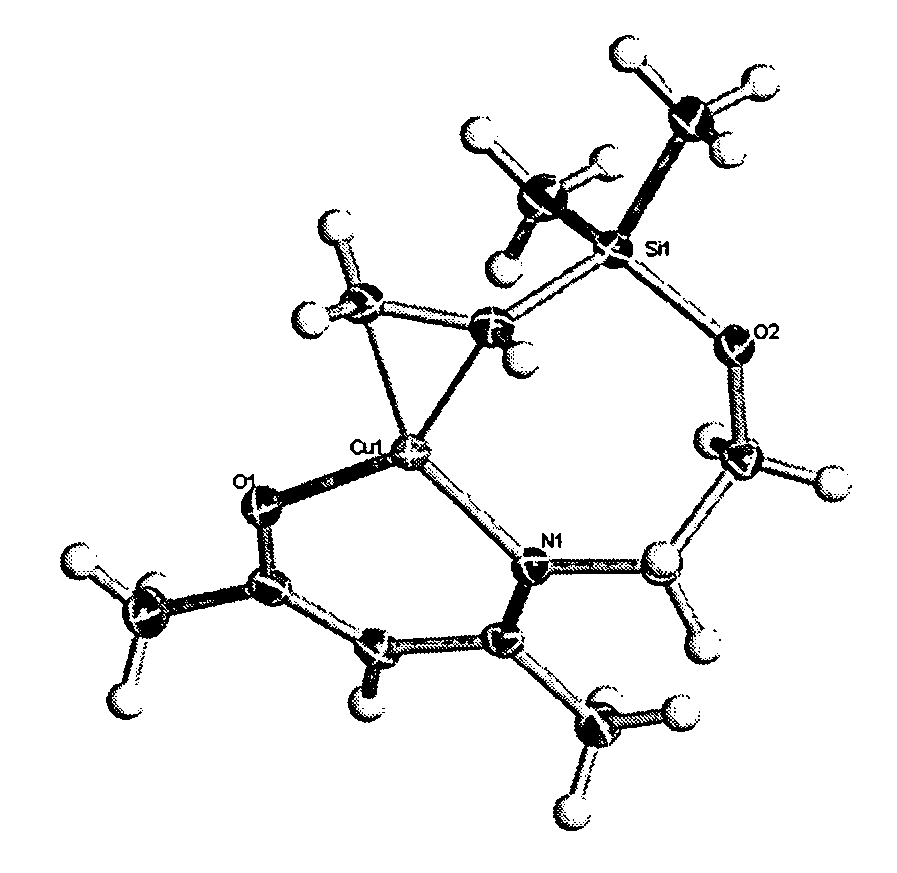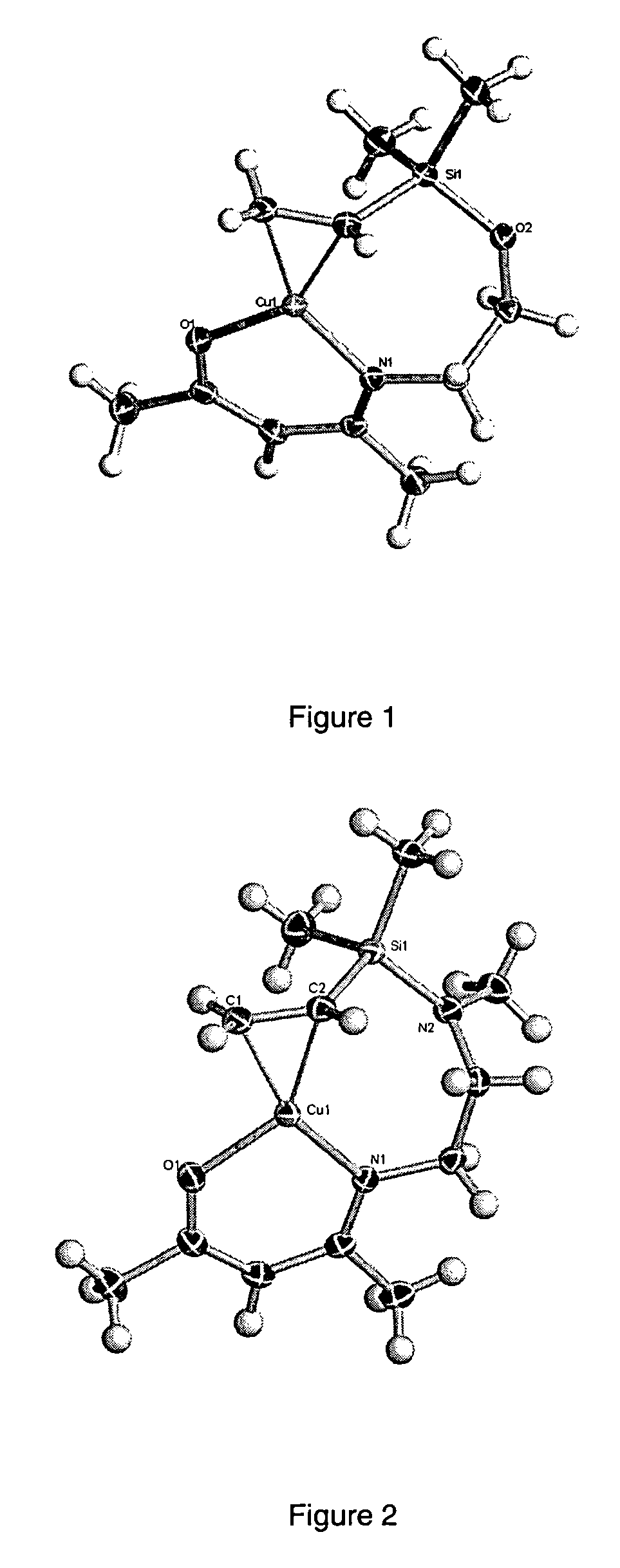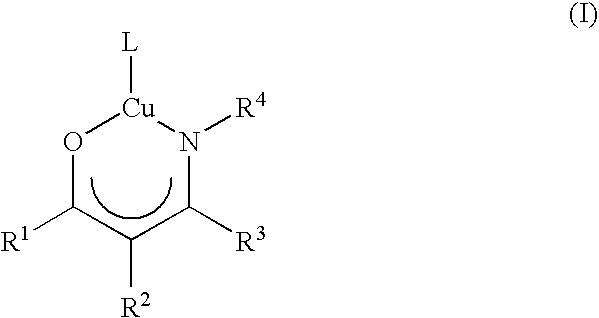Volatile metal beta-ketoiminate and metal beta-diiminate complexes
a technology of metal beta-ketoiminate and complexes, which is applied in the direction of group 3/13 element organic compounds, thermoelectric devices, gold organic compounds, etc., can solve problems such as the type of chemistry that may present problems
- Summary
- Abstract
- Description
- Claims
- Application Information
AI Technical Summary
Benefits of technology
Problems solved by technology
Method used
Image
Examples
example 1
Synthesis of H2NCH2CH2OSiMe2(C2H3)
[0062]80.0 ml (0.57 moles) of chlorodimethylvinylsilane and 79.0 ml (0.57 moles) of triethylamine were mixed together with 2.0 liters of dry hexane and vigorously stirred under an atmosphere of nitrogen at room temperature. 35.0 ml of ethanolamine (0.57 moles) were slowly added over 1 hour resulting in a thick white slurry. The solid triethylamine hydrochloride was filtered off under nitrogen and washed with an additional 1.0 liter of dry hexane. The hexane was then distilled off at atmospheric pressure from the product, yielding 58.0 g (70%). The NMR results for the product were as follows: 1H NMR: (500 MHz, C6D6): δ=0.15(d, 6H), δ=2.8(q, 2H), δ=3.5(t, 2H), δ=5.75(dd, 1H), δ=5.94(dq, 1H), δ=6.17(dq, 1H).
example 2
Synthesis of MeC(O)CH2C(NCH2CH2OSiMe2(C2H3))Me
[0063]58.3 g (0.40 moles) of H2NCH2CH2OSiMe2(C2H3) were slowly added dropwise to 40 g (0.40 moles) of 2,4-pentanedione stirring in 250 ml of THF at room temperature in the presence of excess sodium sulfate. The mixture was stirred for 4 hours then the THF was stripped off under vacuum. The residual oil was then distilled at 120° C. / 20 mTorr to give 35 g of final product (43% yield). The NMR results for the product were as follows:
[0064]1H NMR: (500 MHz, C6D6): δ=0.15 (s, 6H), δ=1.40 (s, 3H), δ=2.0 (s, 3H), δ=2.8 q, 2H), δ=3.27 (q, 2H), δ=4.9 (s, 1H), δ=5.75 (m, 1H), δ=5.95 (m, 1H), δ=6.1 (m, 1H).
example 3
Synthesis of Cu(MeC(O)CHC(NCH2CH2OSiMe2(C2H3))Me)
[0065]17.0 g (0.075 moles) of MeC(O)CH2C(NCH2CH2OSiMe2(C2H3))Me were dissolved in 10.0 ml of dry tetrahydrofuran (THF) solvent and added over 1 hour to 2.5 g (40% excess at 1.04 moles) of sodium hydride stirring in 100 ml of dry THF under an atmosphere of nitrogen and allowed to stir overnight at room temperature. This mixture was filtered under nitrogen then slowly added to 7.5 g (0.075 moles) of copper(I) chloride stirring in 10 ml of dry THF at 0° C. under an atmosphere of nitrogen over a period of 1 hour after which the mixture was allowed to warm to room temperature and stir overnight. The THF was then stripped off under vacuum, 500 ml of deoxygenated dry hexane was added with stirring for 10 minutes prior to filtering. After stripping off the hexane under vacuum, the crude product was obtained as a light blue crystalline mass, yield 15.8 g (73%). Sublimation at 20 mTorr and 70° C. gave a near colorless crystalline sublimate with...
PUM
| Property | Measurement | Unit |
|---|---|---|
| temperature | aaaaa | aaaaa |
| temperatures | aaaaa | aaaaa |
| boiling point | aaaaa | aaaaa |
Abstract
Description
Claims
Application Information
 Login to View More
Login to View More - R&D
- Intellectual Property
- Life Sciences
- Materials
- Tech Scout
- Unparalleled Data Quality
- Higher Quality Content
- 60% Fewer Hallucinations
Browse by: Latest US Patents, China's latest patents, Technical Efficacy Thesaurus, Application Domain, Technology Topic, Popular Technical Reports.
© 2025 PatSnap. All rights reserved.Legal|Privacy policy|Modern Slavery Act Transparency Statement|Sitemap|About US| Contact US: help@patsnap.com



